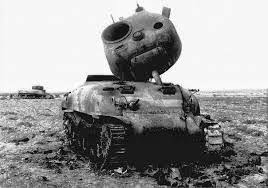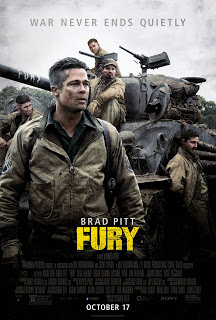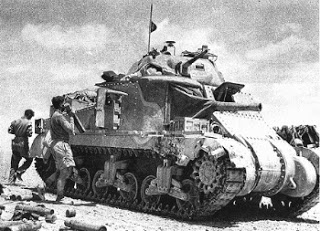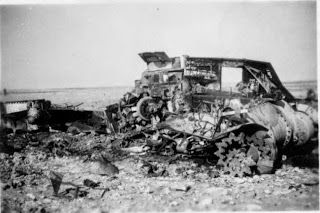Movie Review: Fury.
Rosey had some accumulated days off at work, so yesterday she took one and carried me to see the new war movie, Fury. Fury is a gritty look at armored and armored infantry combat in World War II, and it presents the dangers American tankers and their supporting infantry faced. My Uncle Bill was an armored infantryman in World War II, and I wish now that I had asked him more questions about his experiences when he was alive. One thing that came through loud and clear to me was Bill's absolute hatred of Nazis and especially the SS. From the few conversations I had with him after I was grown up enough to appreciate them, I got the feeling that members of the Waffen SS had a tough time surrendering to Bill's outfit, especially after news of the Malmedy massacre got around. This is portrayed in the movie with unblinking eye.
The time is April 1945 and as the Americans move deeper into Germany they come across evidence of Nazi atrocities, including the summary execution of civilians (including children) who are deemed by the SS to be "deserters" to the cause of the Fatherland. Their bodies are left dangling from telephone poles with signs on them. One SS officer captured in the movie is summarily executed after the burgomaster, in response to a question from Brad Pitt's character, condemns him with a nod as one of the ones who has been executing children.
In another scene, a German soldier is captured wearing a GI overcoat. This outrages the tankers and armored infantrymen. Subsequently he is shot and Rosey did not understand why. He was a prisoner, after all, and due the protections of the Geneva Convention. I pointed out that the coat didn't seem to have any holes in it or blood on it. What pissed off the armored infantrymen was that the guy had probably made his captive strip it off. Had he killed the GI afterward? We cannot know, but the GIs, as with all soldiers in combat, assumed the worst, hence he had to die. Somebody in that unsympathetic crowd was bound to shoot him, although how he meets his end at the unwilling hands of a green replacement is perhaps the most controversial scene in the movie. I don't think my Uncle Bill would have quibbled with it's portrayal, though.
The fact that there were absolutely green replacements with no tank experience used in the latter part of the war is incontrovertible. This was made necessary by the ghastly casualty rates among tankers as they pitted their substandard, poorly armed and armored Shermans against superior German tanks. (Worse than the other defects was the fact that our tanks were gasoline-powered, which made them so susceptible to "brewing up" in a ball of flame when hit that the British called them "Ronsons" after their cigarette lighter.) As Third Armored Division ordnance officer Belton Y. Cooper wrote in his memoir Death Traps The Survival of an American Armored Division in World War II, his division entered France with 232 Sherman tanks, but by the end of the war, it had lost 648 Shermans totally destroyed, and an additional 700 had been knocked out of action and later repaired - a loss rate of 580%. Men -- trained armored crewmen -- died along with those tanks (a full crew for a Sherman was five, although losses often dictated that a tank might have to operate with as few as three men) and the stateside replacements could not be trained fast enough to make good the losses, hence the use of raw place-fillers. That, in turn, got a lot of other good men killed, something that is portrayed in Fury with an unblinking eye.

I was also lucky when I was growing up to live down the road from a one-eyed Buckeye farmer named Cliff McMahon. Mr. McMahon described himself as one of the luckiest men alive. I went to school with one of his sons and participated in 4H so I got to know Cliff, a tanker with the 1st Armored Division, who had lost an eye at Kasserine Pass crewing an M-3 Grant tank. The M-3, predecessor to the Sherman, was even worse, with the main gun, a low velocity 75mm, located in a sponson on the side, making it necessary to traverse the whole tank in order to engage targets on the move. Worse than that, however, was the fact that the Grant had riveted armor plate rather than cast, and when struck even a glancing blow with a German anti-tank projectile, would blow the rivets inward, ricocheting around the inside like so many bullets. It was one of these that took out Cliff's eye and ended his war.
M-3 Grant tank with riveted construction.
Cliff called himself the luckiest man alive because of all the men in his tank company in North Africa, very few survived to the end of the war.
M-3 Grant tank after an encounter with the Germans in North Africa.
Fury, the tank in the movie, is an M4A3E8, known as an "Easy Eight." Upgraded from earlier Shermans in response to its glaring deficiencies, the Easy Eight has much better suspension and a high-velocity 76mm gun which at least gave it a fighting chance against most German tanks, although the frontal armor of the Tigers would still resist them. Most tank-to-tank kills with such behemoths were accomplished by flanking tactics of the more numerous Shermans, getting around the Germans for a flank or rear shot. This was necessarily wasteful of tanks and their precious crews and is portrayed with nail-biting accuracy in Fury.
I had a few quibbles with the final climactic battle scene, but all in all, Fury is one of the best war movies I've ever seen, better certainly than Saving Private Ryan. (Plus, I loved the Grease Guns killing Nazis.)




24 comments:
Just a few words in defense of the M4. The true source of our troubles was bad doctrine but even so the M4 was superior to the Panzer 4, by far the most common German tank. The Germans commonly used captured M4s to fill out their units. They could do this because of the mechanical reliability of an M4 and because German tanks also ran on gasoline. It was the Russians who used diesel.nv
You and Grease Guns... This is turning into a fetish Mike ;-)
I had the opportunity to get to know 7 German Infantrymen, who had been taken prisoner at the battle of Kasserine pass, while stationed in Germany in the early 80's. There story was almost 180 degrees opposite to what we think and learn. Their take on it was that it was strictly more experience that allowed the Germans to push as far as they did. They were also very vocal that the defense was intentionally set up in depth and that it could never have been an accident of chaos. Always interesting to hear the other side of a battle.
Cruachan!
Highlander
Eventually the Sherman was upgraded with water jackets around the ammunition, as well as moving the ammo lower in the hull, which reduced the "brew-up" rate.
http://en.wikipedia.org/wiki/M4_Sherman
I knew a chap who had fought in Normandy, and he mentioned that he and his comrades called these tanks "Ronsons".
With the same grim humour, the Jerries called them "Tommy-cookers".
A different view is from the Belmont Club...
http://pjmedia.com/richardfernandez/2014/10/19/hollywood-and-tanks/
Key point
"Since the Shermans were more numerous and mechanically reliable, they typically got to the key terrain first. They kept going whereas the Panthers and Tigers could only road march short distances from their transporters and railheads. Thus, in most engagements the Shermans could get set up because there were so many of them and they tended to run reliably.
If there was a hill to be grabbed, a road to be blocked, the Shermans would get there first. By contrast, the German tanks were mechanically fragile. For all their power they were on average, late to the party. Therefore, on a fluid battlefield the Shermans would almost always arrive first on the key terrain and bushwhack the panzers. Zaloga’s conclusion was astounding. And yet it may be true."
OH Dear, I'm an old guy and long since have given up the fight of defending the Sherman against Cooper's idiocy. First off we all need to get a grip. Shells ripping through a Tiger do not leave the Wehrmacht crews as if they were kissed by unicorns. Cooper seemed to believe that Sherman crews were torn to pieces while Tiger crews were taken to paradise. Stupid!!! The M-4 had an electric turret which allowed US tank crews to get 3 hits to every one by Wehrmacht tanks. The problem was the gun, which was far to small. German Armaments minster Albert Speer in his book "Inside the Third Reich" laid out the problems of German tank production and the fact is the Tiger and Panther tanks doomed Panzer divisions, they used far too much fuel (which German didn't have), could barely maneuver around muddy battle fields and they could not cross 90% of the bridges in Europe and Russia. But the kicker was this. the US produced 10 tanks for every German tank. It doesn't show up in numbers because the Germans used captured French, Russian, Czech, and even American tanks. American units always had tanks. German Panzer units killed us at 3 to 1 early on but we always had them at 5 to 1. In places like the Po valley in Italy we virtually destroyed the Wehrmacht because their tanks were too heavy to deploy, while our Shermans ran wild. Wehrmacht Panzer officers were begging for a Sherman sized tank, and that's what the Panther was supposed to be until Hitler go a hold of it. Tigers were a disaster with a good gun. Wehrmacht tanks, starting with the Mk IV and going into the Tiger and Panther, destroyed Shermans at a rate of 3 to 1 for the simple reason that we lacked a gun, not armor, not maneuverability. In fact the 88 on the Tiger would have easily penetrated the Tiger's own armor. The "Easy 8" was the solution and we never looked back from that point. It also need to be pointed out that our tank production took place 5000 miles from the European battlefield. The Germans were producing overly complicated, hand made behemoths that insured their own defeat. David Fletcher of the Bovington Royal Tank Museum once told me that he followed each and every Tiger from a Panzer Bn sent to Greece. Not a one was destroyed by enemy action. They all broke down, ran out of fuel and were stuck in rivers, creeks and mud... or abandoned for lack of parts. Does that sound like something we should have copied? Fletcher believed that with superior Wehrmacht training of crews and doctrine they should have stuck with the Panzer Mk IV and done much better. OK, I could go on like this for another 10 to 100,000 words, but no one wants that.
RIP Uncle Bill.
His hatred of nazi's and the SS would have guaranteed we'd have gotten along just fine.
Well, based on this review I'm going to watch it.
Merle
Interesting footnote: the late-war Waffen-SS troops were often not SS. They were Luftwaffe ground crews and Kriegsmarine personnel with no ships who got dragooned in to the SS.
The Sherman was never really meant for tank-on-tank battle. It was designed to assault enemy infantry. At the time American armored doctrine favored an entirely separate class of vehicle, the tank destroyer, for the role of knocking out enemy tanks. But as they say, you go to war with what you have. And we had plenty of Shermans.
I usually avoid anything emanating from Hollywood, but given your review here I think I will go see Fury.
Doctrine, for what it was worth, was for tank destroyers--with better armor and guns--to engage tanks, and for the Sherman to support infantry, a role it was well suited for. They didn't do so well against enemy armor, but they were EVERYWHERE. If an Allied unit needed tanks, they had them. As stated, German tanks had issues, and were actually rather rare--they did their job of supporting the infantry, which eventually won the war.
We also decided to stick with Shermans, which we could make, and more importantly ship, 3 or more to 1 to the heavier tanks we did have. For individual crews it could be a bad deal but the people making the decisions were looking at a much bigger picture.
That had to suck for DKM crews.... The DKM had a large part that had no Nazi allegiance, and were simply,trying to delay the war long enough for someone to off Hitler, or otherwise get some sort of peace established - to same Germany from the bitcher's knife.
To have been placed into SS groups would have been devastating to them.
Actually, Loren, our TDs had even lighter armor, albeit better, high-velocity guns. Recall that the turrets even lacked a roof, being open to Feldwebel Schmidt's potato mashers in city fighting, for pity's sake. The only advantage an M-18 Hellcat had, aside from its high-velocity 76mm gun, was that it was jack-rabbit fast and the German tanks, whose turrets were manually traversed, couldn't track them fast enough. I knew a couple of M-18 veterans and, although proud of their TDs, they were damn glad, if not astonished, to have survived the war.
I can't help but comment that the lesson from all of this was that quantity overcomes quality. In the air or on the ground. Funny though, it is a lesson that the US soon forgot, in the air and on the ground. We got very lucky that no hot war took place with the Soviets as they stayed with the lesson of numbers. Had a war occurred we would have quickly had to resort to battlefield nukes to stop them.
In "Panzer Leader" Heinz Guderian discusses his problems with the tanks he had in detail. The Pz.Pkfw IV in it's basic form was his favorite in part because he had a lot of them. The problem he faced with it was that the people back in Berlin wouldn't leave the design alone. He didn't just have to contend with one, or a few, variants, he had dozens with incompatible parts from one IV to the next. So his motor pool people couldn't take parts from two broken IV's and put one in service.
Where we made one Sherman and made a lot of them, and the Soviets cranked out T38's en masse, the Germans seemed to be stuck in a "trick of the week" mode on arms production in many areas, not just in tanks. This limited their total output and battlefield availability in many areas. Consider the odds against four Me 262's being jumped by a hundred P51D's, followed back to their airfield and strafed to destruction upon landing. Yes the 262 was the superior aircraft. But it was too little, too late, and had inadequate support infrastructure.
Rats....
I know better than to type early in the morning. Too much blood in my caffeine stream.
Where I typed T38 should be T34. Getting my tanks (T34) and pistols P38) swapped. I have one and wish my wife would let me have the other ;-)
One other point:
Both variants of the Tiger used gasoline for fuel and were notorious for leaky fuel systems. There were reports of Tigers in combat with puddles of gasoline sloshing about. So when one did get a solid hit it burned just as brightly as any Sherman.
The part about shooting the German in the GI coat was totally accurate. My father wrote about the same situation. Orders from Supreme Command were to shoot any German captured wearing any part of an allied uniform, and Dad ordered two Germans shot accordingly during the Battle of the Bulge. Unfortunately, because they were so young, nobody would do it, forcing Dad to do it himself. But when he walked over and saw how young they were he couldn't do it either. (http://jpattitude.com/091111.php) The Germans were getting desperate by that point and throwing youngsters into the line, and the two boys were probably just cold, not spies. The point is, the shootings were ordered from the top, it wasn't a decision that was being made at the frontline level.
Little off topic but still ww2, in my neighborhood I grew up in ny we had a lot of ww2 and Korean vets, well I learned at some point from my old man that Mr x across the street had been shot down over Germany and spent 3 years in a German prison camp. I learned Mr y up the street was also a ww2 vet but, he was wermacht and fought on the other side but had been allowed to immigrate to the US. I never saw them talk to each other ever at any block party or event or what ever, ever. In the 20 years I lived on that street. On another thought, my dad fought in Korea and absolutely hated whistles, anytime any of us kids brought home cheap whistles from wherever, he would throw them out. He also slept with a 45 under his pillow till around 1980. He started getting mellowed out around then and sold it and just had a snub nose chiefs 38 special in his top dresser drawer...
Saw the movie last week. Overall pretty good, but I do have a few beefs:
First, why was so much time wasted on the apartment scene with the two women? That 25-minute sequence could have been limited to 10.
Second, why is Brad Pitt carrying an MP44? The only way you can get ammo is to take it off dead Germans, and that rifle was not all that common.
Third, the "Picket's Charge" across a large open field against the Tiger. Total suicide. In reality they would have coordinated better and done a real flanking maneuver instead.
Lastly, the final battle. What kind of a tank crew (with a crippled tank) decides to hold fast and take on a battalion of 300+ SS who are humping a bunch of panzerfaust, MG34's and MG42's? One with a death wish, that's what. Any crew with any sense would have run away from there in a hurry. Those certainly were very loooooooooong fuses on those German potato-masher grenades that were thrown inside. And those had to have been the most incompetent soldaten of the entire war.
I found Saving Private Ryan to be a better movie and the ending of Fury to be preposterous. 200-300 men with many Panzerschreck's couldn't take out a disabled tank? Not believable, and even myself, with very limited training, could have succeeded in taking the tank out. Up to that point I thought the movie was good.
It was a good war-adventure movie, 2.5 hours of near-continual slaughter. It is "Glory" for WWII. There's plenty of character development and themes of Christianity are laced throughout the dialogue which I wish got more and deeper exploration. Some of the most emotional scenes for me were the recitations of John 2:15 and Isiah 6:8 in the face of their certain destruction.
One thing that annoyed me about the movie was the evil "lord of the rings" music (I say that tongue firmly in cheek) that played every time a German soldier was on the move. I guess they carried gramophones with Wagner queued up or something? Anyway, it becomes kind of comical after the fifth time the music is used to color the German approach.
Post a Comment